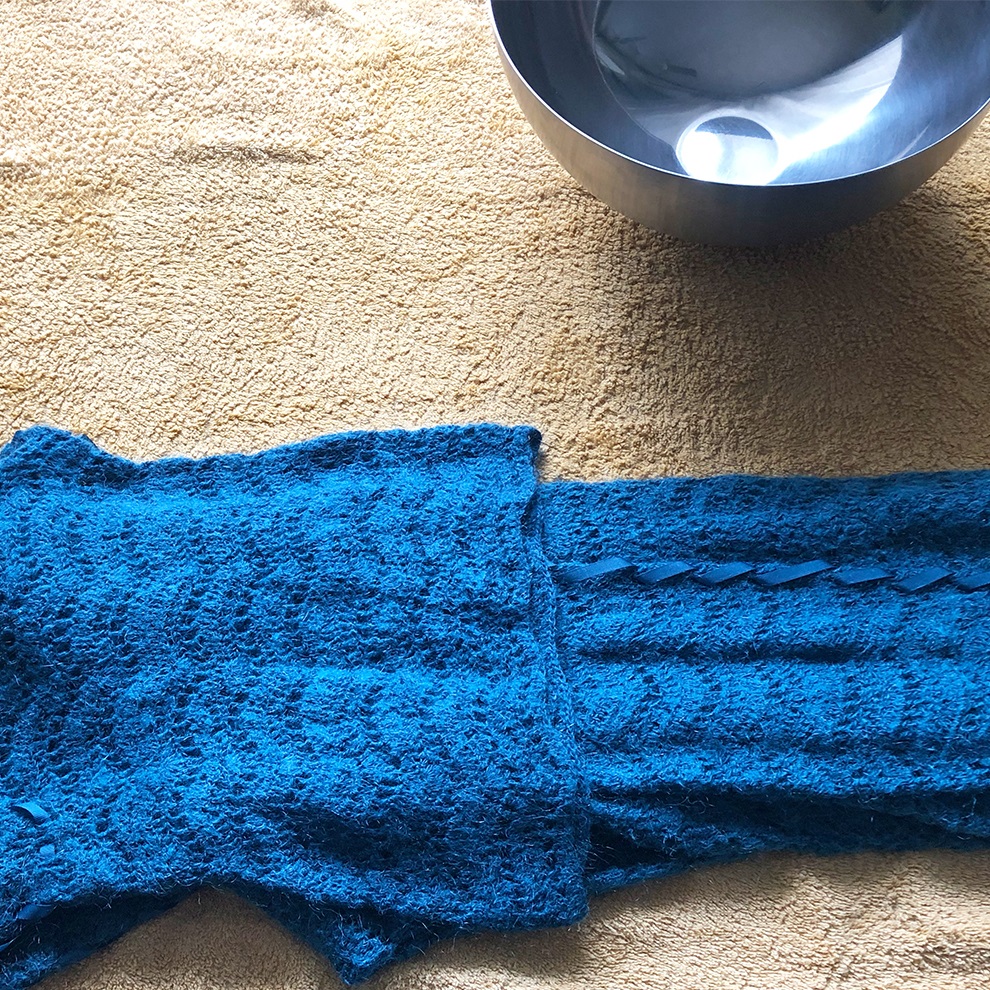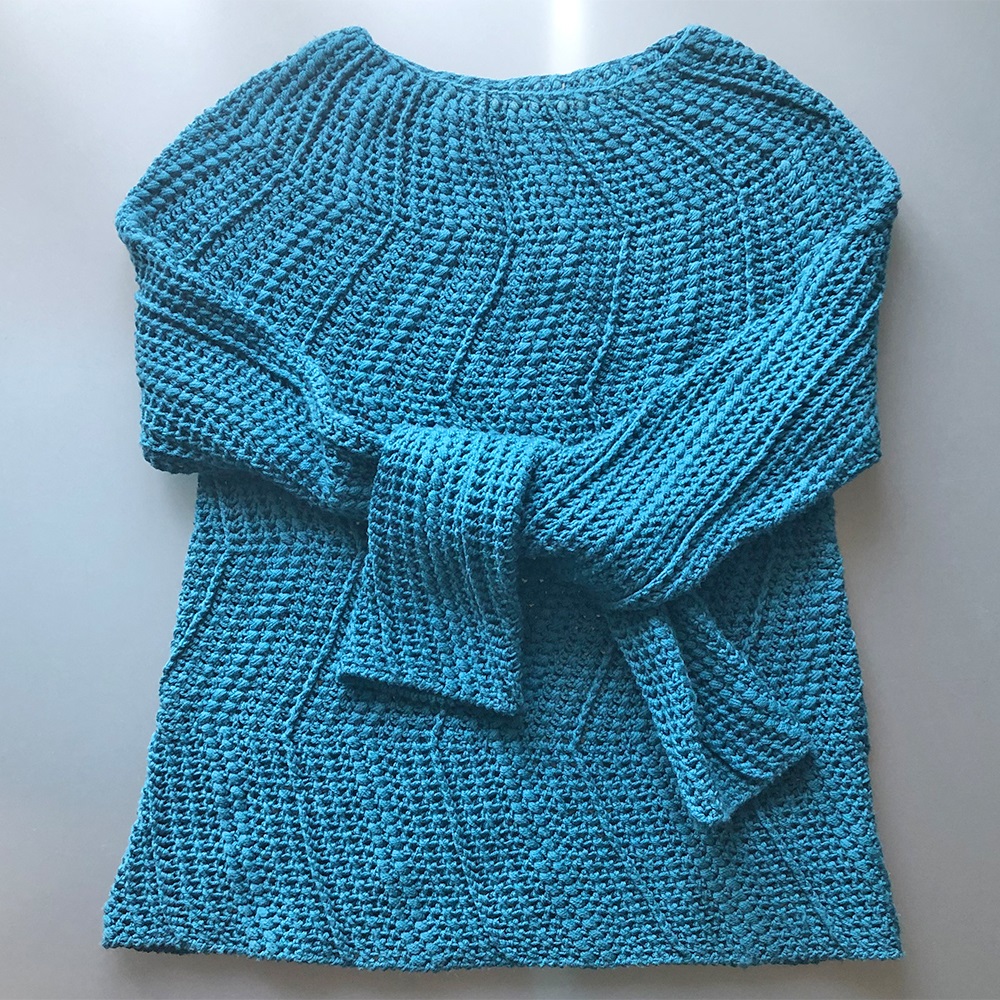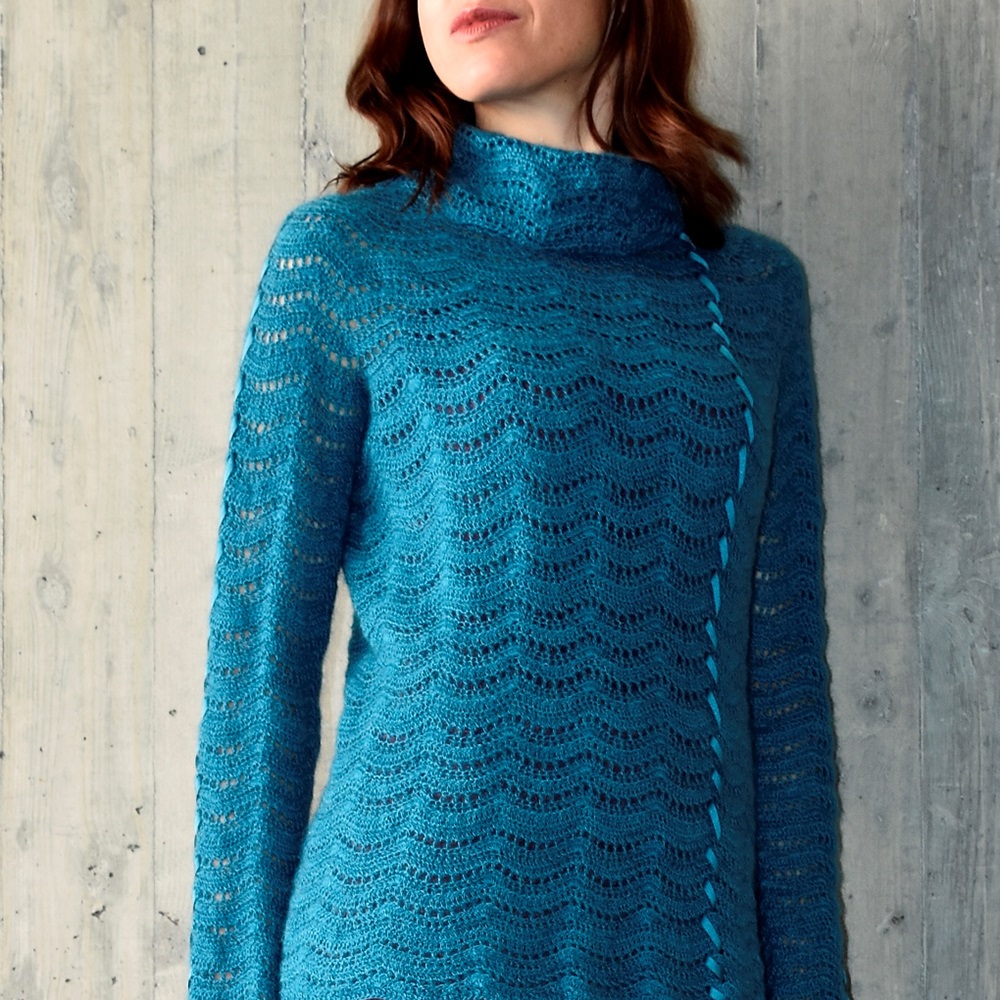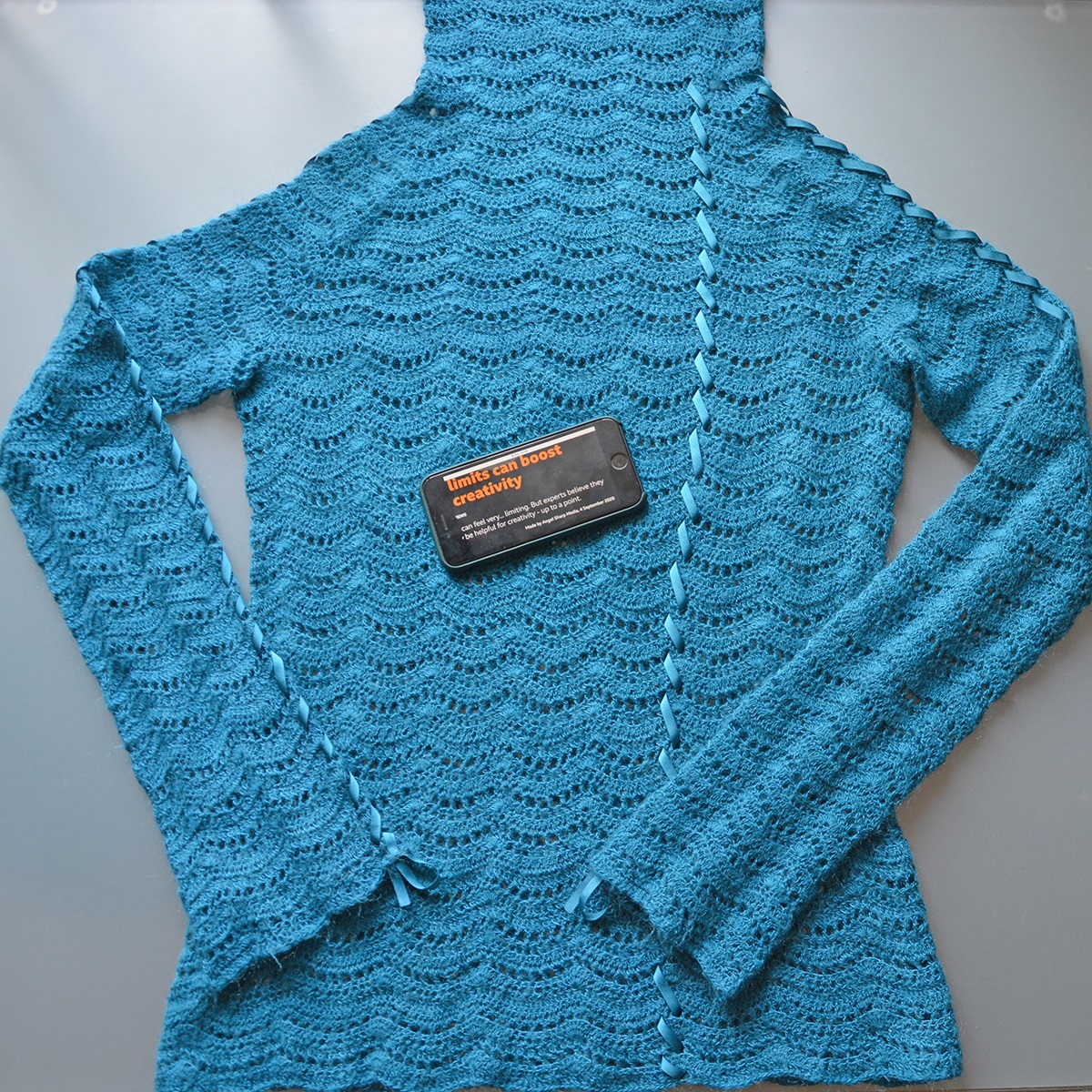***
A while ago I made a cardi with not well twisted wool/acrylic blend and after a few days of wearing it I could see those annoying tiny fuzz balls that ruined the look of my cardi, so I will not buy this yarn for my future garment projects. On the contrary, I could not praise more the look of several handmade sweaters made with the superwash wool even after a few years of wearing them (you can see one of them below).
But let’s discuss why the yarn pills and what could be done to minimize pilling in your handmade sweaters?
A few basics:
🔷 Knitted/crocheted handmade sweaters pill more than woven fabrics because stitches have large spaces between them and fibers are not held together tightly – there’s more area for the abrasion to take place, especially if the yarn is not twisted tightly. In other words, the higher the twist, the firmer your sweater. The looser the weave of the yarn, the more prone it will be to pilling.
Thus, RULE 1: Choose designs that require tighter knit/crochet over a looser one and a tightly woven yarn.
🔷 Yarn is made of long or short fibers; the latter are more likely to pill. Synthetics have more tiny ends that can get tangled together and create pills (as opposed to long fibers, like silk, linen). Handmade sweaters that combine natural and synthetic fibers (cotton/polyester or wool/acrylic blends), are more likely to pill because one fiber is stronger than the other. The weaker fiber will break, knot around to the stronger fiber, and a pill is formed.
Thus, RULE 2: Choose yarns made with long fibers, even if they are more expensive, avoid fiber blends unless you are making cheap hat-glove-scarf sets or kids’ garments that last one season and then they pill awfully.
But you have already crocheted a sweater that looks rough and dowdy even after the first wash/wear. Like my cardi :(.
Are there some tricks that will keep your EXISTING sweaters looking their best longer? Sweater-shavers would not be a great solution because crochet stitches have an uneven texture and if you shave too much, you could ruin your favorite handmade garment.
So, we are left with washing and care.
RULE 3: Washing.
– Wash sweaters inside out to prevent excessive abrasion to the right side from other clothes, zippers, or buttons. The pills will show up mostly on the backside.
– Wash handmade sweaters individually – the pill becomes a magnet for other loose threads in other clothes and the threads become entangled. That’s why a black garment often catches little white knots (fuzz) from another fabric. Here I wash my pink knit sweater first, then my turquoise crochet sweater:


– Use a laundry detergent with enzymes. The enzyme will help break down small pills and remove some of those loose, short fibers that tend to pill.
– Washing sweaters by hand is easy, more gently and completely worth it for extending the life and shape of your handmade sweaters. Put your wool sweater in cold or lukewarm water with a delicate detergent, submerge one hand so it touches the garment and agitate it a bit so the water shows some movement, let it soak for 5-10 minutes.
– Rinse sweaters with fresh cold water. Add a fabric softener to the rinse cycle – it will coat the surface of your sweater so that abrasion is lessened.
– Avoid wringing or aggressively squeezing your knitted/crocheted sweater. Since your sweater is heavy with water push it against the walls of the tub to get out excess moisture.
– Dry your sweater by placing on a flat towel and rolling from the bottom up to get out excess moisture. Lay the whole sweater on a flat drying surface (make sure no piece is hanging off because the stitches will stretch out there), arrange the shoulders and sleeves so it has its proper form.



– For sweaters that need a last-minute refresh before you wear them, try using an iron with the steam setting on gently passed over your sweater. But generally avoid heat when washing or drying.
– Fold your sweater when not wearing it – you don’t wish to stretch out the shoulders and arms and ruin the shape. This is especially important for sweaters with HUGE stitches. I personally hang one of my wool cardigans that I crocheted with a small 2-mm hook so I can wear it anytime. I know that these small stitches will not stretch anymore :). This is how my cardigan sweater looks like today (compare to photos that were taken almost 5 years ago: https://conceptcreativeblog.2016/01/16/diagonal-jacket-pattern/ ). Not bad, right?
RULE 4: Care.
– Pilling comes from excessive wear. These fuzzy bobbles in sweaters appear on the areas that receive the most abrasion, such as under the arms, around the cuffs and on elbows. The tiny ends in short-fiber yarn will break every time when your sweater is rubbed or abraded. To minimize the pilling try not to rub your garment against any surface – pull your sleeves up if you are going to write, type or even drink a cup of tea to prevent your sweater’s elbows look worn-out.
– Jewelry will rub the fiber, so it’s better to leave it at home when you wear your treasured sweater. For the same reason it’s better to avoid any zippers and buttons near your sweater because they will cause more harm to the fiber during wearing and washing your sweater.
– Try to hold all bags in your hand and not across your shoulder. You do not wish to have one side or one shoulder look worn-out.

– Do not wear sweaters that can pill under other garments (a coat) to prevent excessive rubbing.
– Only wash your sweater when it needs it, and avoid friction. Wool sweaters don’t have to be washed super often, as long as you thoroughly air them out in between wears.
Hope it helps!
Below you can see my favorite two handmade sweaters that I wear on a regular basis and take on most trips because they are comfortable, light weight and they always look great on me. I mention the recommended yarn and show whether the look of these sweaters has changed over time.
My Detour sweater still looks great after one year of intensive wear :).

Here I recommend to use 100 % superwash merino Fingering-weight = 1 = Super Fine (USA) = 4 ply (UK). Such as:
www.ravelry.com/yarns/library/yarna-juli–
www.ravelry.com/yarns/library/debbie-bliss-rialto-4-ply
www.ravelry.com/yarns/library/viking-of-norway-baby-ull
www.ravelry.com/yarns/library/louet-gems-fingering-weight
www.ravelry.com/yarns/library/create-with-adlibris-baby-merino
www.ravelry.com/yarns/library/5th-avenue-superwash-merino-wool
www.ravelry.com/yarns/library/king-cole-anti-tickle-merino-blend-4-ply
What’s the difference between merino and superwash merino? In superwash the producers have removed and suppressed all those tiny scales that cover each individual fiber and then coated the yarn to compress and smooth the fibers and make the yarn dense and even. The scales on fiber are what help yarns hold together when they are spun and plied. Since some of the natural structure is missing from the yarn, the fibers in this yarn have no natural way to grip each other. The yarn is splitty, less elastic, more drapey, and it compresses easily. The fibers are twisted around each other, but not locked together. Because the fibers aren’t hanging on to each other, superwash yarns work best for drapey garments like shawls and are not good for cable knits that require great stitch definition.
Remember that gauge with superwash and usual wool yarn DIFFERS.


This sweater exists in solid and colorful version. My solid-colored sweater has no waist-shaping, suggestions on how to make it fitted to your waist and how to crochet a sweater dress are included. This top down seamless sweater is designed without a humpback that is so common in circular yoke sweaters. The raised back and bust darts create a better fit, while the stretchy fabric will feel like a second skin.
The pattern includes charts, written instructions and photo-tutorial of stitches. Get it from:
www.RAVELRY.com/patterns/library/detour-sweater
www.ETSY.com/listing/735251329/detour-modern-crochet-sweater-pattern
My website:
https://conceptcreative.store/shop/detour-crochet-sweater-pattern-crochet-tutorial-in-english/
This mohair-nylon crochet sweater was made in October 2015 and it looks perfect even after FIVE years of wearing it.
Usually any fiber that does not tend to absorb water – polyester, nylon – tends to pill, which is not the case here. Photo below was taken after completion: 
This is how it looks like after 5 years of wearing it (a few photos above show how I dried it yesterday :)):
The date of this BBC video on my phone proves that these photos could not be taken before September 2020 :).
I strongly believe that it’s better to care for existing sweaters and avoid yarns that create a fuzzy look soon. Personally I don’t need to crochet too many sweaters, but every of them should look its best.
I would suggest to use one of these yarns for my mohair-nylon sweater:
www.ravelry.com/yarns/library/seam-angora-fine
www.ravelry.com/yarns/library/lang-yarns-lusso
www.ravelry.com/yarns/library/patons-uk-misty
www.ravelry.com/yarns/library/schachenmayr-nomotta-kid-light
A lace-weight merino will work too :).
Get this sweater pattern from:
www.RAVELRY.com/patterns/library/mohair-wavy-pullover
www.ETSY.com/listing/154189502/raglan-crochet-sweater-pattern
My website: https://conceptcreative.store/shop/fluctuation-sweater-crochet-pattern-crochet-tutorial/
I usually show my handmade garments in my Instagram account, feel free to follow me and crochet/knit some of my patterns.
Happy crafting!






